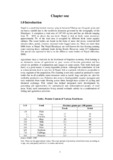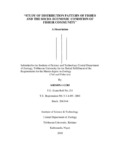Please use this identifier to cite or link to this item:
https://elibrary.tucl.edu.np/handle/123456789/3544| Title: | “Study of Distribution Pattern of Fishes and the Socio- Economic Condition of Fisher Community” |
| Authors: | Giri, Krishna |
| Keywords: | Distribution pattern;Socio-economic |
| Issue Date: | 2010 |
| Publisher: | Central Department of Zoology |
| Institute Name: | Central Department of Zoology |
| Level: | Masters |
| Abstract: | The present study entitled “Study of Distribution pattern of fishes and the socio- economic condition of fisher community” deals with the distribution pattern of fishes in Phewa lake, diversity and frequency occurrence of fishes along with the socio-economic condition of fisher community residing the Phewa Lake and fishing implements. During the present investigation altogether 21 species of fishes belonging to 5 orders vig. Cypriniformes, Siluriformes, Perciformes, Beloniformes and Synbranchiformes. They belong to 6 families, 11 genus and 16 species. Most of the common and dominant species from Phewa Lake are found to be Cyprinids which contributes about 84% of the total catch. The distribution pattern of fishes like Channa gachua, Puntius sarana and Garra annandalei were found to be clumped where as rest of the fishes were uniformly distributed. The highest frequency occurrence of fish was found to be of Puntius sophore i.e. 11.69% and the lowest was of Schizothorax richardsonii i.e. 0.97%. The socio-economic condition of fisher community residing the vicinity of Lake Phewa revealed their low economic status. More than 37% of the fisher community is totally illiterate. Among the literate also 43% are under S.L.C. The fisher man having low economic condition and the occasional fisherman wore found to use non-conventional fishing practices such as poisoning, electro-fishing and dynamiting. Conventional fishing practices were found to be in practice by full time fisherman. The natural fish habitat is being destroyed in the Phewa Lake due to large number of environmental factors such as deforestation, landslides, soil erosion and floods, silt deposition and human activities such as discharge of municipal sewages directly into the Lake, washing clothes by using soap and detergent in the Lake and the excessive use of chemical fertilizers in the agricultural field by the farmers. Key words: Distribution pattern, Socio-economic, Clumped, Jalari community, Conventional. |
| URI: | http://elibrary.tucl.edu.np/handle/123456789/3544 |
| Appears in Collections: | Zoology |
Files in This Item:
| File | Description | Size | Format | |
|---|---|---|---|---|
| Chapter.pdf | 668.28 kB | Adobe PDF |  View/Open | |
| Cover.pdf | 43.88 kB | Adobe PDF |  View/Open |
Items in DSpace are protected by copyright, with all rights reserved, unless otherwise indicated.
